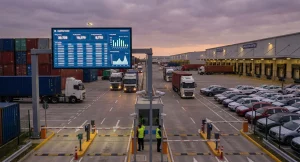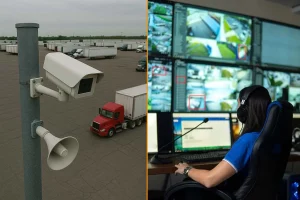Logistics operations are under constant pressure to move faster while cutting costs. Yet many fleets still rely on manual gatehouses staffed 24/7, making the entry point one of the most expensive and inefficient parts of the yard.
Automated gate management is changing that. By combining AI, real-time supervision, and digital workflows, logistics companies are turning security from a cost center into a source of measurable savings. Here are five ways automation is reducing labor costs and improving efficiency across North America’s busiest yards.
1. Eliminating Continuous On-Site Guard Costs
Traditional gatehouses require multiple shifts of guards to manage vehicle entry and exit. Between overtime, turnover, and training, these costs add up quickly.
According to the U.S. Bureau of Labor Statistics, the median annual wage for security guards was $38,370 in 2024, with experienced industrial guards earning significantly more once shift premiums and benefits are factored in. In large logistics yards, this often means $45,000 to $50,000 per guard annually.
By automating gate verification and driver identification, companies can dramatically reduce the number of on-site guards without sacrificing control. Birdseye Security Solutions’ AI-driven systems have helped major distribution centers cut monthly security costs by up to 60 percent, while maintaining 99.99 percent accuracy in operations.
2. Reducing Idle Time and Driver Delays
Every minute a truck spends waiting at the gate is money lost. Manual check-ins, paper logs, and miscommunication can delay drivers and hurt productivity.
A Federal Motor Carrier Safety Administration study found that detention times exceeding two hours occur on nearly one-third of carrier trips, directly impacting delivery schedules and labor efficiency.
Automated gate systems integrate with yard management platforms to pre-authorize drivers, verify documents, and capture license plate data instantly. Facilities using automation report 50 percent faster processing times, allowing them to move more loads per shift with fewer people on site.
3. Centralizing Oversight With Remote Agents
Rather than hiring guards at every gate, automation allows one team of trained remote agents to monitor multiple facilities. High-resolution video, AI analytics, and integrated communication tools give those agents complete visibility into gate activity in real time.
This centralized model, a core part of Birdseye’s Maximum Telepresence Approach, blends AI detection with human decision-making. It allows one remote team to manage thousands of gate transactions daily, saving labor while improving consistency and compliance.
4. Minimizing Administrative Work
Manual gate logs and paper-based Bills of Lading can consume hours of clerical time every week. Automation removes that burden by digitizing credential checks, seal verification, and document capture.
According to McKinsey & Company, logistics firms that digitalize documentation workflows can cut administrative labor by up to 40 percent and reduce costly errors that lead to compliance issues.
Automated gates ensure every event is recorded, time-stamped, and easily searchable — eliminating manual data entry and creating a complete audit trail.
5. Preventing Theft and After-Hours Overtime
Cargo theft cost North American carriers more than $130 million in reported losses in 2024, according to CargoNet. When incidents occur, companies often spend additional labor hours investigating, coordinating with law enforcement, and replacing guards.
AI-powered gate management systems prevent many of these events before they happen. Automated deterrence, credential verification, and real-time alerts keep the yard secure without increasing staffing. This proactive approach saves not only security wages but also the overtime often required for post-incident recovery.
From Cost Center to Command Center
Automated gate management doesn’t just replace guards — it enhances visibility, compliance, and efficiency across the entire operation. With AI analytics and centralized monitoring, the gate becomes a control tower for yard performance.
The result is a safer, smarter, and more cost-efficient operation that helps logistics leaders reinvest savings where they matter most.




